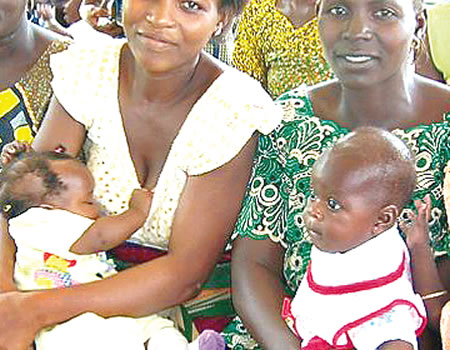Last month, Nollywood mourned a veteran, Moji Olaiya. The actress was said to have passed away in Canada two months after having a baby due to cardiac arrest. She reportedly had her first child about 20 years ago and didn’t have another until some months ago at the age of 42. One would wonder why a woman who successfully gave birth would die after two months of cardiac arrest.
Did she wait too long to have another baby or was the pregnancy and the cardiac arrest totally unrelated?
While one cannot say the exact reason for the cardiac arrest, both scenarios exemplifies the reason why Healthy Timing and Spacing of Pregnancy (HTSP) should be strongly advised when women are trying to conceive. Practising HTSP is important because it helps women to plan pregnancy at the healthiest times of their lives when they and their children are more likely to survive and stay healthy, experts say.
Over the past few years, the United States Agency for International Development (USAID) has sponsored a series of studies on pregnancy spacing and health outcomes. The research objective was to assess, from the best available evidence, the effects of pregnancy spacing on maternal, newborn and child health outcomes.
The World Health Organization (WHO), a few years ago, convened a panel of 30 technical experts to review six USAID-sponsored studies. Based on their review of the evidence, the technical experts made the following recommendations:
- After a live birth, the recommended minimum interval before attempting the next pregnancy is at least 24 months in order to reduce the risk of adverse maternal, perinatal and infant outcomes.
- After a miscarriage or induced abortion, the recommended minimum interval to next pregnancy is at least six months in order to reduce risks of adverse maternal and perinatal outcomes.
Research has shown that birth-to-pregnancy intervals of fewer than six months (equivalent to a 15-month birth-to-birth interval) are associated with increased risk of conditions such as third trimester bleeding, premature rupture of membranes, puerperal endometritis and anemia.
David Oladeji of the Department of Family, Nutrition and Consumer Services, Obafemi Awolowo University and J.A Ayangunna of the Department of Social Work, University of Ibadan, after their study on spacing in February 2017, published the paper “Birth Spacing Influence on Maternal and Child Health in Nigeria” in the International Journal of Women’s Health. Based on the findings of their study they recommended that “nursing mothers should be made to be aware of the inherent dangers of inadequate birth spacing such as increased risk of premature membrane rupture, uteroplacental bleeding disorders, poor health for both mother and child, miscarriage or induced abortion and consequently death.”
Researchers say that babies born to women who get pregnant very quickly after having a child or wait many years between children are at greater risk for potentially serious delivery-related complications, including premature birth and low birth weight.
The analysis of studies involving more than 11 million women as was published in the Journal of the American Medical Association revealed that infants born to women who conceived less than six months after giving birth had a 40 per cent increased risk for being born prematurely and a 61 per cent increased risk of low birth weight, compared with infants born to mothers who waited 18 months to two years between pregnancies.
Babies whose mothers had their previous child at least five years earlier had a 20 per cent to 43 per cent greater risk for being born prematurely, having a low birth weight, or being small for their gestational age.
Although timing may not be everything, the analysis suggests that better pregnancy spacing could have a dramatic impact on neonatal complications and deaths.
Dr Patrick O’Brien, a consultant obstetrician at the Royal College of Obstetricians and Gynaecologists (RCOG) in the United States of America, emphasised the importance of appropriate birth spacing and the potential risks of preterm birth as a result of inadequate spacing between pregnancies.
“As obstetricians, we would generally recommend that a woman should wait at least 12 months in between pregnancies. However, other factors and individual circumstances must be taken into account, such as maternal age or pre-existing health conditions. These confounding factors may determine whether a woman chooses to conceive slightly earlier than recommended.”
In the same vein, while so many studies have shown the deleterious effect of short birth spacing interval on maternal, perinatal and neonatal outcome, little attention has been given to the effect of prolonged birth spacing interval on labour outcome.
According to experts, “often times when women with prolonged birth spacing interval present in booking clinic, they are rated high risk.”
Dr E.O. Orji of the department of Obsteristics and Gyneacology, Obafemi Awolowo University, Ile-Ife and his team of researchers in the paper “Effect of prolonged birth spacing on maternal and perinatal outcome” published in the East African Medical Journal, concluded based on their findings that there was no significant difference in maternal and perinatal outcome in pregnancy between women with prolonged birth spacing and those with inadequate birth spacing. In other words, both situations carry the same medical consequences for a woman.
Benefits of HTSP
Global Health Learning advises that when couples practice HTSP, families experience direct health benefits:
- Improved maternal health: reduced risk of anaemia, premature rupture of membranes, pre-eclampsia, haemorrhage, abortion, miscarriage, and maternal death
- Improved newborn health: reduced risk that a subsequent pregnancy will result in premature birth or low birth weight, lowers the risk of perinatal or neonatal death, and enhances the likelihood of longer duration of breastfeeding
- Improved nutritional status: increased likelihood of healthy growth due to spacing of births approximately three years apart
- Reduces unsafe abortion: reduced rate of unintended pregnancy and unsafe abortion.
- Also, according to experts, healthy spacing and timing helps in the following areas:
- Baby can be born at the right time and have a healthy weight.
- Baby can develop well because Mom can give lots of attention to the baby.
- Mom will have more energy and be less “stressed out”.
- Mom will have more time to bond with the baby.
- Future babies will be healthier because Mom’s body had enough time to replace nutrient stores before getting pregnant again.
- Children who are adequately spaced are better prepared to begin kindergarten, and perform better in school.
- Mom has more time to spend with the child and the child receives more attention and assistance with developmental tasks.
- Families have more time to bond with each child.
- Parents have more time for each other.
- Parents can have time to themselves.
- Families can have less financial stress.
WATCH TOP VIDEOS FROM NIGERIAN TRIBUNE TV
- Let’s Talk About SELF-AWARENESS
- Is Your Confidence Mistaken for Pride? Let’s talk about it
- Is Etiquette About Perfection…Or Just Not Being Rude?
- Top Psychologist Reveal 3 Signs You’re Struggling With Imposter Syndrome
- Do You Pick Up Work-Related Calls at Midnight or Never? Let’s Talk About Boundaries






